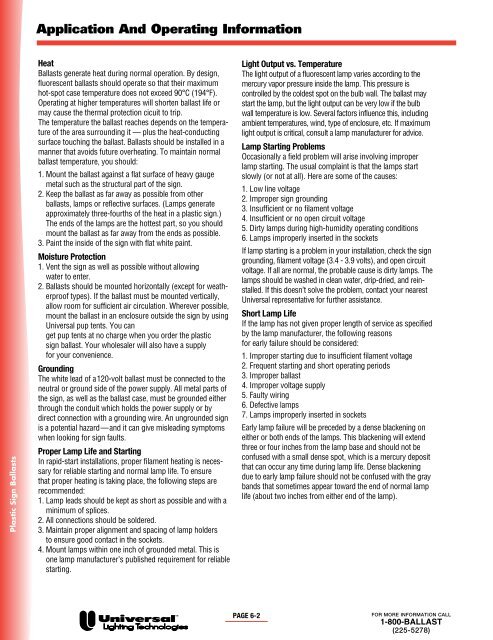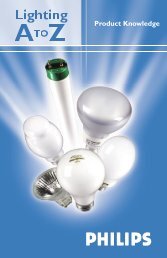triad® electronic ballasts - Conserve-A-Watt Lighting, Inc
triad® electronic ballasts - Conserve-A-Watt Lighting, Inc
triad® electronic ballasts - Conserve-A-Watt Lighting, Inc
Create successful ePaper yourself
Turn your PDF publications into a flip-book with our unique Google optimized e-Paper software.
Application And Operating InformationPlastic Sign BallastsHeatBallasts generate heat during normal operation. By design,fluorescent <strong>ballasts</strong> should operate so that their maximumhot-spot case temperature does not exceed 90°C (194°F).Operating at higher temperatures will shorten ballast life ormay cause the thermal protection cicuit to trip.The temperature the ballast reaches depends on the temperatureof the area surrounding it — plus the heat-conductingsurface touching the ballast. Ballasts should be installed in amanner that avoids future overheating. To maintain normalballast temperature, you should:1. Mount the ballast against a flat surface of heavy gaugemetal such as the structural part of the sign.2. Keep the ballast as far away as possible from other<strong>ballasts</strong>, lamps or reflective surfaces. (Lamps generateapproximately three-fourths of the heat in a plastic sign.)The ends of the lamps are the hottest part, so you shouldmount the ballast as far away from the ends as possible.3. Paint the inside of the sign with flat white paint.Moisture Protection1. Vent the sign as well as possible without allowingwater to enter.2. Ballasts should be mounted horizontally (except for weatherprooftypes). If the ballast must be mounted vertically,allow room for sufficient air circulation. Wherever possible,mount the ballast in an enclosure outside the sign by usingUniversal pup tents. You canget pup tents at no charge when you order the plasticsign ballast. Your wholesaler will also have a supplyfor your convenience.GroundingThe white lead of a 120-volt ballast must be connected to theneutral or ground side of the power supply. All metal parts ofthe sign, as well as the ballast case, must be grounded eitherthrough the conduit which holds the power supply or bydirect connection with a grounding wire. An ungrounded signis a potential hazard—and it can give misleading symptomswhen looking for sign faults.Proper Lamp Life and StartingIn rapid-start installations, proper filament heating is necessaryfor reliable starting and normal lamp life. To ensurethat proper heating is taking place, the following steps arerecommended:1. Lamp leads should be kept as short as possible and with aminimum of splices.2. All connections should be soldered.3. Maintain proper alignment and spacing of lamp holdersto ensure good contact in the sockets.4. Mount lamps within one inch of grounded metal. This isone lamp manufacturer’s published requirement for reliablestarting.Light Output vs. TemperatureThe light output of a fluorescent lamp varies according to themercury vapor pressure inside the lamp. This pressure iscontrolled by the coldest spot on the bulb wall. The ballast maystart the lamp, but the light output can be very low if the bulbwall temperature is low. Several factors influence this, includingambient temperatures, wind, type of enclosure, etc. If maximumlight output is critical, consult a lamp manufacturer for advice.Lamp Starting ProblemsOccasionally a field problem will arise involving improperlamp starting. The usual complaint is that the lamps startslowly (or not at all). Here are some of the causes:1. Low line voltage2. Improper sign grounding3. Insufficient or no filament voltage4. Insufficient or no open circuit voltage5. Dirty lamps during high-humidity operating conditions6. Lamps improperly inserted in the socketsIf lamp starting is a problem in your installation, check the signgrounding, filament voltage (3.4 - 3.9 volts), and open circuitvoltage. If all are normal, the probable cause is dirty lamps. Thelamps should be washed in clean water, drip-dried, and reinstalled.If this doesn’t solve the problem, contact your nearestUniversal representative for further assistance.Short Lamp LifeIf the lamp has not given proper length of service as specifiedby the lamp manufacturer, the following reasonsfor early failure should be considered:1. Improper starting due to insufficient filament voltage2. Frequent starting and short operating periods3. Improper ballast4. Improper voltage supply5. Faulty wiring6. Defective lamps7. Lamps improperly inserted in socketsEarly lamp failure will be preceded by a dense blackening oneither or both ends of the lamps. This blackening will extendthree or four inches from the lamp base and should not beconfused with a small dense spot, which is a mercury depositthat can occur any time during lamp life. Dense blackeningdue to early lamp failure should not be confused with the graybands that sometimes appear toward the end of normal lamplife (about two inches from either end of the lamp).PAGE 6-2FOR MORE INFORMATION CALL1-800-BALLAST(225-5278)




